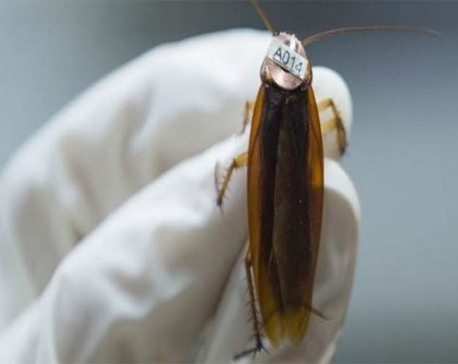
OR
7 Great Scientists Who Were Born on Christmas Day
Published On: December 25, 2018 02:30 PM NPT By: Agencies


WIKIMEDIA COMMONS // PUBLIC DOMAIN
From the man who discovered titanium to a prehistoric plant expert, these Christmas kids helped us better understand the natural world and our place within it.
1. JOHN PHILLIPS (1800-1874)
John Phillips was born on December 25, 1800. In 1808, when he was just 7, he lost both of his parents in quick succession and was taken in by his uncle William Smith, a surveyor and fossil hunter known as the “Father of English Geology.” Later in life, Phillips also became a great geologist, and in the 1840s, he drew upon his uncle’s work to identify and name three significant eras in Earth’s history: the Paleozoic, Mesozoic, and Cenozoic. He also authored several papers on the subject of astronomy.
2. WILLIAM GREGOR (1761-1817)
A British chemist, mineralogist, painter, clergyman, and Christmas kid, William Gregor is primarily remembered as the man who discovered titanium. He first came across a sample of this element on the sandy banks of a stream that ran near the Cornish village of Manaccan (also spelled Menaccan) in 1790. The following year, Gregor wrote a paper about the newfound metal, and in honor of its place of origin, he proposed calling the element either menacanite or menachine. Ultimately, though, the German chemist Martin Klaproth independently discovered titanium in 1796, and this was the name that stuck.
3. RICHARD E. SHOPE (1901-1966)

WIKIMEDIA COMMONS // PUBLIC DOMAIN
In 1918 and 1919, an influenza pandemic killed between 20 and 50 million people worldwide; in the United States, 28 percent of all citizens came down with the disease, which claimed 10 times as many American lives as World War I. Meanwhile, pigs in the Midwestern U.S. were dying of a similar illness.
Richard E. Shope, a pathologist employed by the Rockefeller Institute for Medical Research, suspected the two outbreaks were related. So in 1928, Shope visited Iowa—where he had been born on Christmas Day in 1901—to investigate a possible link between the two illnesses.
At the time, scientists believed that influenza was caused by a bacteria of some kind—so when he arrived in Iowa, Shope began searching infected swine for microscopic suspects. He managed to identify a bacteria species that was present in most of the runny-nosed pigs he examined. However, when he injected this one-celled organism into healthy pigs, they failed to contract the disease.
Starting again, Shope looked for other potential disease-carriers within the sick pigs’ mucus. In 1931, he filtered the samples to remove any bacteria and introduced this new filtrate to some non-infected swine. Soon, the control pigs came down with a mild case of porcine influenza, proving that the flu was caused by a “filter-passing agent”—in this case, a virus. When Shope combined the virus with the bacteria, the test animals came down with more severe symptoms. Encouraged by his results, American and British scientists conducted a series of tests, which showed that human and pig influenza were indeed close relatives. Building off of Shope’s research, a British team went on to isolate the human influenza virus for the very first time in 1933. If it hadn’t been for this breakthrough, flu vaccines might not exist today.
4. GERHARD HERZBERG (1904-1999)
Spectroscopy is a technique that allows scientists to study the interactions between matter and electromagnetic radiation. By most accounts, Gerhard Herzberg literally wrote the book on this subject: His classic three-volume textbook titled Molecular Spectra and Molecular Structure has been nicknamed “the spectroscopist’s bible” [PDF].
Herzberg came into the world on December 25, 1904 in Hamburg, Germany. His passion for science blossomed at an early age: As a boy, he could often be found reading up on chemistry and astronomy in his spare time. By the time Herzberg turned 25, he’d earned a Ph.D. in engineering physics and gotten 12 scientific papers published. In the mid-1930s, the rise of Nazism drove Herzberg and his Jewish wife—fellow spectroscopist Lusie Oettinger—out of their native Germany. They relocated to Canada, which Herzberg would call home for the better part of seven decades. Over time, several different fields—including astronomy and chemistry—would benefit from his command of spectroscopy. Using the process, Herzberg was able to detect hydrogen gas molecules in Uranus and Neptune’s atmospheres in 1952. Spectroscopy also helped the scientist shed some new light on free radicals (atoms or groups of atoms with an odd number of electrons). Herzberg’s incredible body of work earned him the Nobel Prize for chemistry in 1971.
5. INNA A. DOBRUSKINA (1933-2014)
Paleobotanist Inna Dobruskina was arguably the world’s leading authority on plant life during the Triassic period, which occurred between 252 and 201 million years ago. She was born in one of Moscow’s “communal apartments” on December 25, 1933. As an adult, she taught at the Geological Institute of the Soviet Academy of Sciences—and risked incarceration by secretly distributing anti-Communist pamphlets for several years. In 1989, she emigrated to Israel, where she became a faculty member at the Hebrew University of Jerusalem. Her life’s work took her around the world; by the time Drobuskina passed away in 2014, she’d prospected Triassic deposits in such countries as China, France, Austria, South Africa, Russia, and the United States [PDF].
During her days in the U.S.S.R., Dobruskina was often confronted with workplace sexism. On one Sino-Soviet expedition along the Amur River, her male subordinates dared her to imbibe a shot of undiluted alcohol. Determined to put them all in their place, Dobruskina gulped down enough to fill an entire 250-milliliter glass (a shot is just 44 milliliters). Afterwards, the men on that team never tried to challenge her again.
6. ADOLF WINDAUS (1876-1959)
Another Nobel laureate who happened to have been born on Christmas Day, this Berlin native took home the 1928 Nobel Prize for chemistry. The award was granted to Windaus in recognition of the lifetime’s worth of research he’d conducted on sterols, a class of organic compounds that includes cholesterol. Windaus’s interest in this topic began shortly after he earned a Ph.D. in chemistry from the University of Freiburg. At the time, little was known about sterols, and the scientist dedicated his career to plugging the gaps in our understanding of them. Through careful research, Windaus would discover that these compounds are closely akin to bile acids. He also learned that a fungal sterol called ergosterol can be utilized to cure rickets. Furthermore, it was Windaus who first determined the chemical composition of Vitamin D.
7. ISAAC NEWTON (1642/43-1726/27)
WIKIMEDIA COMMONS // PUBLIC DOMAIN
If you could somehow resurrect Isaac Newton for an interview, he’d tell you that he was born on December 25, 1642—but modern historians cite January 4, 1643 as his actual birthday.
Confused? Take it up with Julius Caesar. In 45 BCE, the Roman dictator implemented a standardized, 365-day calendar (with leap years every four years, eventually) we now call the “Julian calendar.” Unfortunately, it relied on astronomical calculations that overestimated the time it takes the Earth to complete one full rotation around the sun by 11 minutes and 14 seconds. As the centuries passed, those extra minutes and seconds added up; by the mid-1500s, the Julian calendar had fallen about 10 days out of sync with the planet’s rotation. Clearly, something had to be done. So in 1582 CE, Pope Gregory XIII mandated a new calendar. Dubbed the “Gregorian calendar,” it was designed to facilitate some much-needed leap year reform (among other things). The Pope also erased the synchronization problem that the Julian Calendar had created by eliminating 10 full days from 1582. So Thursday, October 4 of that year was immediately followed by Friday, October 15.
But while Roman Catholic countries like France and Spain adopted the Gregorian calendar right away, Great Britain—Newton’s birthplace—didn’t follow suit until 1752. When the UK and its colonies finally implemented this calendar, they did so by striking 11 days from existence, doing away with September 3 through September 13. At the time, Ben Franklin is said to have remarked, “It is pleasant for an old man to go to sleep on September 2 and not have to wake up until September 14.”
By then, Isaac Newton had been dead for years. According to the Julian Calendar, he was born in 1642 and died in 1726. However, for consistency’s sake, historians have retroactively adjusted all pre-1752 years to conform to the Gregorian calendar—so today’s scholars cite January 4, 1643 as Newton’s birthday and March 31, 1727 as his death day (another part of the reform was to move when the New Year was celebrated, meaning Newton died before the new year under the Julian Calendar, but after under Gregorian). So there you have it: Arguably the greatest scientist in history both is and isn’t a Christmas baby.
You May Like This

Pure as snow? Scientists say air carrying plastics to Arctic
BERLIN, August 15: Scientists say they’ve found an abundance of tiny plastic particles in Arctic snow, indicating that so-called microplastics... Read More...

Scientists built a robotic cockroach that can walk on water
The Ambulatory Microrobot, known as HAMR, uses multifunctional foot pads that rely on surface tension when it needs to swim. Read More...

Asia Pacific Conference: A platform for Young Scientists
KATHMANDU, Nov 2: With slogan ‘Our young scientists: our strength, our hope’, the sixth Asia Pacific Conference of Young Scientists (APCYS... Read More...







Just In
- NRB to provide collateral-free loans to foreign employment seekers
- NEB to publish Grade 12 results next week
- Body handover begins; Relatives remain dissatisfied with insurance, compensation amount
- NC defers its plan to join Koshi govt
- NRB to review microfinance loan interest rate
- 134 dead in floods and landslides since onset of monsoon this year
- Mahakali Irrigation Project sees only 22 percent physical progress in 18 years
- Singapore now holds world's most powerful passport; Nepal stays at 98th











Leave A Comment